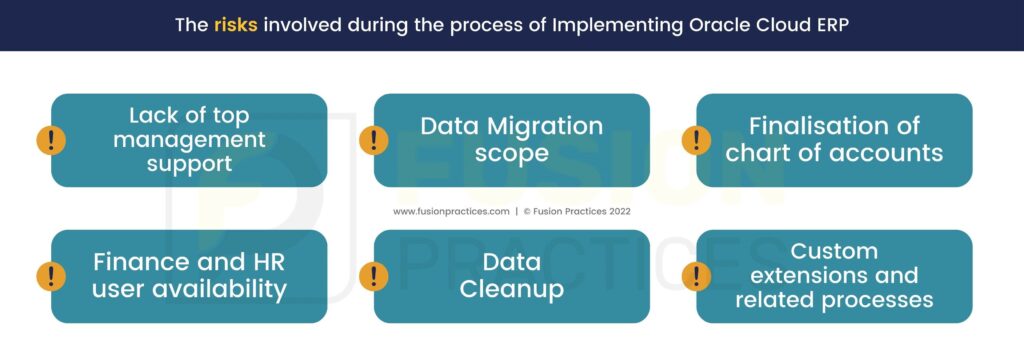Unmanaged risks can easily prevent a project from achieving objectives or even cause it to fail to succeed. Risk management is important during project initiation, planning, and execution; well-managed risks significantly increase the likelihood of project success. To ensure a project’s success, determining how a system implementation partner will handle potential risks so that they can be identified, mitigated or avoided is essential.
During Oracle Cloud ERP Implementation, multiple risks can impede the smooth process of transition. Based on our years of experience, Fusion Practices is mindful of all the risks involved during the process which can impact Oracle Cloud ERP implementation projects. We have also determined the mitigation actions that should be put in place to reduce the probability and/or impact of an adverse risk to be within acceptable threshold limits.
The risks involved during the process of Implementing Oracle Cloud ERP are highlighted in the below image:

Below is a holistic list of risks and their mitigating actions taken by Fusion Practices:
Risk 1: Lack of Top Management commitment and support
Mitigating Actions:
- The Oracle Cloud ERP implementation cannot be simply perceived as an “IT project.” Fusion Practices recommends a steering committee with senior executive representation from the business areas that are affected by the implementation. The steering committee receives regular updates on the project and is consulted by the project team when key issues or decisions cannot be resolved by the project team.
- Fusion Practices ensures that a Senior Engagement workshop is organized so that they remain engaged in the process of transition.
Risk 2: Poor adoption by end-users
Mitigating Actions:
- A Training Plan is arranged by Fusion Practices in coordination with the customer.
- Fusion Practices’ methodology incorporates demonstrations at 3 different stages to build up familiarity and to ensure users are engaged and their feedback is incorporated.
- A formal change management process is suggested if further changes are required after the 3 demonstration phases.
Risk 3: Loss of data
Mitigating Action:
Fusion Practices will work with the customer in updating and following the procedures defined in the business continuity and disaster recovery plan.
Risk 4: Insufficient testing phase
Mitigating Action:
- The following test stages are scheduled, with contingency, in the project plan:
(i) unit testing, (ii) integration testing, and (iii) user acceptance testing (UAT).
- The business involved defines full end-to-end testing scenarios that simulate real-world business transactions.
- Fusion Practices generates documented test scripts based on business feedback and business scenarios (instead of ad hoc testing).
- A stable test environment, subject to tight change control, is always used.
- Use of end-user access security roles to conduct later stages of integration testing and UAT phase.
Risk 5: Pandemic impacting resource
Mitigating Action:
Fusion Practices has a cross-functional business continuity and pandemic preparedness team which meets on a regular basis to monitor the situation. Certain policies are in place to protect our staff such as home working and accessibility of all necessary systems and tools to ensure work can continue safely. We continually reinforce and update our preparation plans. These include business continuity, technology management, communications and facilities.
Risk 6: Insufficient format of data feed from external sources and failing to load
Mitigating Action:
- Fusion Practices engages in the correct formats and ensures testing is conducted early to achieve a timely resolution.
- Fusion Practices ensures an alert/reporting mechanism is set up to identify errors so it can be fixed promptly, or workaround arranged.
- Allocation recommendation of product SMEs for downstream and upstream integrations of external systems.
- Fusion Practices works with providers and customer to agree on an integration strategy approach.
- Fusion Practices integrates at least 20% of data for Product Demonstration-1 and 80% during Product Demonstration-2 to provide time to get data problems resolved.
Risk 7: Unknown data migration and archival process
Mitigating Action:
The Project plan engages with the customer and identifies these requirements early on to ensure that any impact on timelines is understood and acted upon.
Risk 8: Finalisation of chart of account and cost centre structures
Mitigating Action:
We ensure checkpoints at beginning of a project to check status and dependencies.
Risk 9: Finance and HR user availability
Mitigating Action:
a) The Fusion Practices project plan states upfront the dates required to provide time for the relevant SMEs to be made available.
b) As part of the project initiation a communication plan is put together to jointly agree on involvement, roles responsibilities and communication methods.
Risk 10: Data Clean-up process
Mitigating Action:
a) Fusion Practices agrees on a communication plan and Responsibility Assignment Matrix (RACI) from the outset with all parties involved. To formulate an agreed approach and communication to enable action plans, if action is required by any other third parties.
b) We include tasks in the plan for data cleansing activities. Assumptions around this are documented.
Risk 11: Custom extensions that could be suitable for a SAAS solution
Mitigating Action:
Fusion Practices builds a catalogue of all the custom extensions and understands whether the target state is part of standard functionality or whether suitable for a SAAS solution. We estimate to allow for some of this scenario in our pricing and make it clear in the assumptions what we have based it on.
Risk 12: Unknowns around your manual processes and how they can be simplified
Mitigating Action:
As part of the requirements analysis phase, the as-is processes and to-be processes are mapped and compared with:
- Oracle Fusion capabilities
- Data integration opportunities
- Business process automation
- Process standardisation
Options are presented if Oracle Cloud doesn’t fully meet the requirements. To-be processes are documented to reflect the improvements required.
Want to know how an annual report can be linked to an Oracle Cloud ERP implementation to make the implementation smoother and more effective? Click here to read





